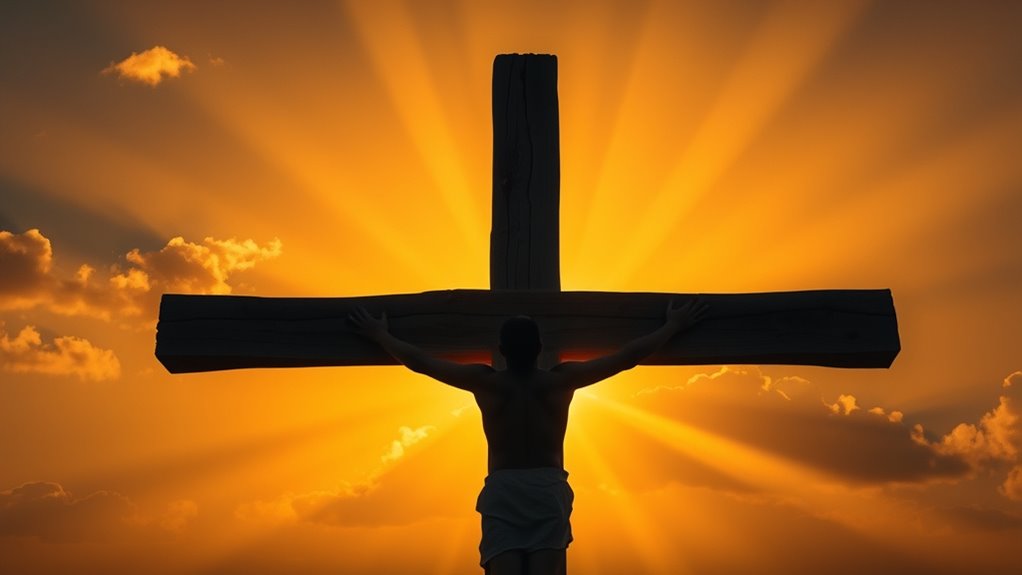The cross symbolizes God’s unwavering love and the sacrifice Jesus made to offer forgiveness, hope, and redemption for you. His death fulfills biblical prophecies and demonstrates divine justice and mercy. It acts as a bridge to reconciliation, healing broken relationships and restoring spiritual unity. The cross is a powerful symbol of transformation, showing that love and grace can overcome even the deepest wounds. Keep exploring to discover how this sacrifice continues to change lives today.
Key Takeaways
- Jesus’ death fulfills biblical prophecy and demonstrates God’s divine plan for salvation and justice.
- The cross symbolizes God’s unconditional love, sacrifice, and the gift of forgiveness for humanity’s sins.
- Jesus’ sacrifice bridges the gap caused by sin, restoring spiritual unity and offering reconciliation with God.
- The cross is a universal emblem of hope, mercy, and renewal across cultures and traditions.
- His death opens the way for spiritual transformation, new beginnings, and eternal hope for believers.
The Significance of Sacrifice in Christianity

In Christianity, sacrifice holds a central place because it symbolizes the ultimate act of love and devotion. The symbolic meaning of sacrifice reflects the idea of giving selflessly for others’ well-being. It demonstrates the depth of God’s love and His willingness to extend grace through Jesus’ death. The cultural significance of sacrifice is deeply rooted in biblical history and traditions, serving as a powerful reminder of redemption and hope. When you think about the cross, you see more than a physical object; you see a representation of sacrifice that transcends time and culture. It invites believers to emulate love and self-denial, emphasizing that true devotion involves giving for a greater good. The materials used in candle making, such as wax and fragrance, also symbolize purity and dedication, mirroring the spiritual sacrifices made in faith. This understanding shapes the core values of Christian faith and practice.
The Fulfillment of Prophecy Through Jesus’ Death

Jesus’ death is often seen as the moment when biblical prophecy is fulfilled, confirming God’s plan for salvation. It marks the ultimate Old Testament fulfillment of Messianic Prophecies, showing how Jesus embodies the promised Savior. You can see this in numerous prophecies fulfilled through His crucifixion, reinforcing that His death was part of God’s divine plan. The detailed alignment of these prophecies highlights the diverse designs used to illustrate His suffering and sacrifice. Key aspects include: – The suffering servant in Isaiah 53 – The piercing of Jesus’ side fulfilling Zechariah 12:10 – The betrayal for thirty pieces of silver (Zechariah 11:12) – His hands and feet being nailed (Psalm 22:16) – The rejection and abandonment foretold in Psalm 22. These prophetic fulfillments demonstrate how Jesus’ death aligns with ancient prophecies, confirming His role as the Messiah. Moreover, the prophetic accuracy underscores the divine orchestration behind His sacrifice and its significance in salvation history. This alignment emphasizes the divine plan, reassuring believers of the certainty and purpose behind Christ’s sacrifice.
The Concept of Redemption and Forgiveness

The cross shows how forgiveness is made possible through sacrifice, offering you a path to healing. It also reveals redemption’s power to restore what was broken and bring new hope. Through grace, you receive fresh beginnings and the chance to start anew. This act of love exemplifies the core message of compassion and spiritual principles that guide faith. Additionally, the symbolism of the cross in various traditions emphasizes redemption stories that inspire believers worldwide. Recognizing how mind-body connections facilitate healing can deepen appreciation for the transformative nature of this sacrifice, demonstrating that true renewal involves both spiritual and physical renewal.
Forgiveness Through Sacrifice
Forgiveness through sacrifice lies at the heart of the Christian understanding of redemption. When Jesus dies on the cross, it’s more than a physical act; it’s a symbolic symbolism of divine love and mercy. The cross’s spiritual significance reveals how sacrifice bridges the gap between humanity and God, offering a path to forgiveness. The act of sacrifice demonstrates that true redemption involves surrender and love. It’s not just about punishment, but about restoring broken relationships. Through this sacrificial act, you’re reminded that forgiveness isn’t earned but given freely through grace. Additionally, the concept of Leave No Trace principles in creating a tranquil environment illustrates how intentional focus and awareness can deepen spiritual understanding and emotional healing. Understanding alimony laws can also serve as a reminder that justice and fairness are essential components of healing and reconciliation in relationships.
Redemption’s Restorative Power
Redemption’s restorative power lies in its ability to heal broken relationships and renew the human spirit. When Jesus sacrificed Himself on the cross, He left behind a legacy of martyrdom’s enduring significance, emphasizing love’s ultimate sacrifice. This act transformed the cross into a powerful cultural symbolism—representing forgiveness, hope, and reconciliation. You’re invited to see how this symbol restores what was once fractured, mending the wounds of sin and separation. Jesus’s death not only offers personal forgiveness but also restores harmony between humanity and God. Through His sacrifice, you experience a profound renewal, understanding that redemption isn’t just about individual salvation, but about restoring the collective fabric of human relationships. The symbolic significance of the cross continues to resonate, shaping hearts and cultures across generations. Recognizing its cultural impact helps us appreciate how this symbol has endured as a universal emblem of love and reconciliation. Additionally, understanding the theological meaning behind Jesus’s death deepens the appreciation of its enduring importance in Christian faith and practice. Moreover, the cross’s cultural symbolism emphasizes its role as a universal emblem of love, sacrifice, and hope across diverse societies and eras. Exploring the sound design behind this powerful symbol reveals how auditory elements can evoke the emotional depth and enduring significance of the cross in various media and cultural expressions.
Grace and New Beginnings
When Jesus sacrificed Himself on the cross, He opened the door to grace and new beginnings, offering a fresh start for anyone willing to accept it. Through His sacrifice, you receive forgiveness, allowing you to leave behind past mistakes and embrace spiritual renewal. This act unlocks heavenly blessings, filling your life with hope and purpose. Grace isn’t just about forgiveness; it’s an invitation to transform your heart and soul. The cross signifies a chance to start over, regardless of your past. Embracing this gift renews your spirit and connects you to divine mercy and eternal hope. The power of electric dirt bikes demonstrates how innovation can lead to sustainable and efficient transportation, inspiring hope for a cleaner future. Practicing mindful decluttering strategies can help you clear away spiritual and emotional clutter, making space for divine grace to work more fully in your life. Recognizing the cultural significance of the cross can deepen your understanding of its profound meaning in redemption and forgiveness. Moreover, understanding the trustworthiness and vulnerabilities of AI in our modern world highlights the importance of discernment and wisdom in embracing technological advancements.
Demonstrating God’s Unconditional Love

The cross vividly demonstrates God’s unconditional love, showing that His compassion and grace extend beyond our mistakes and shortcomings. Its symbolic symbolism reveals deep truths about His willingness to sacrifice for us, regardless of our faults. In the historical context, crucifixion was a brutal form of execution, yet Jesus’s death transformed it into a powerful sign of love and redemption. This act wasn’t about punishment alone; it reflected God’s unwavering commitment to save us despite our flaws. By willingly dying on the cross, Jesus displayed a love that’s unconditional—one that offers forgiveness and hope to all. You can see this love not as earned, but as a gift freely given, emphasizing that nothing can separate you from God’s grace. Divine sacrifice exemplifies the ultimate expression of love and selflessness, reinforcing the profound significance of Jesus’s death. Prophetic dreams can sometimes serve as spiritual messages reinforcing God’s unwavering love and the hope offered through such divine acts.
The Cross as a Bridge to Reconciliation

The cross brings us back into harmony by restoring broken relationships, both with others and with God. It acts as a bridge that closes the gap created by sin and separation. Through Jesus’ sacrifice, reconciliation becomes possible, uniting us once again with the divine and each other.
Restoring Broken Relationships
Have you ever wondered how broken relationships can truly be mended? The cross serves as a powerful bridge to reconciliation, offering hope for healing even the deepest wounds. Through Jesus’ sacrifice, you’re reminded that forgiveness is possible, and restored trust can happen. Whether it’s marriage counseling, mending family ties, or rebuilding friendships, the cross points us toward reconciliation. It encourages humility, repentance, and grace—all essential for healing. When you seek to restore relationships, remember that Jesus’s sacrifice provides the foundation for genuine reconciliation. His love invites you to forgive, ask for forgiveness, and move forward with renewed hope. The cross doesn’t just reconcile us to God; it also restores broken human relationships, making peace possible again.
- Embracing humility and forgiveness
- Seeking guidance through marriage counseling
- Engaging in honest communication
- Extending grace and patience
- Pursuing family reconciliation
Bridging the Divine Gap
Restoring broken relationships often begins with humility, forgiveness, and honest communication. The cross acts as a bridge to reconciliation by addressing the divine justice that separates us from God. Jesus’ sacrifice satisfies God’s demand for justice, making it possible for you to be forgiven and restored. Through His death, the gap created by sin is bridged, allowing for spiritual unity between humanity and the Divine. Instead of leaving you distant and condemned, the cross invites you into a relationship rooted in grace and truth. It transforms the divide into a pathway for connection, where divine justice is fulfilled and spiritual unity is restored. This act of love makes reconciliation possible, turning separation into harmony.
How Jesus’ Death Continues to Transform Lives

Jesus’ death consistently has a profound impact on lives today, offering hope and renewal to those who embrace its significance. Across cultures, the cross symbolizes sacrifice, redemption, and love, transforming personal faith and understanding. Historical perspectives reveal how the cross shifted from a brutal execution device to a symbol of salvation, inspiring millions worldwide. When you reflect on Jesus’ death, you see how it breaks down barriers and invites forgiveness. It’s a powerful reminder that love and sacrifice can bring healing and new beginnings. The cross continues to shape lives by encouraging compassion, humility, and faith. Its universal symbolism reminds you of the depth of divine love and the possibility of transformation through grace.
- Cross cultural symbolism’s influence on faith
- Historical perspectives shaping modern beliefs
- The cross as a symbol of hope
- Personal transformation through sacrifice
- Embracing love and forgiveness
Frequently Asked Questions
How Does Jesus’ Death Impact Non-Christians Today?
Your perspective on Jesus’ death can influence how you engage in interfaith dialogue, fostering respect and understanding. For non-Christians, His sacrifice might serve as a moral influence, inspiring acts of love and forgiveness. Recognizing this impact encourages open conversations, helping bridge differences and promote shared values. Ultimately, Jesus’ death continues to shape moral and spiritual discussions, impacting even those outside the Christian faith by emphasizing compassion and moral growth.
What Are the Historical Origins of the Cross as a Symbol?
You might find that the cross’s origins trace back to Roman executions, where it served as a brutal method of punishment. Over time, it also absorbed pagan symbolism, representing sacrifice and renewal in various cultures. As a symbol, it evolved from a tool of death to one of hope and spiritual significance, especially within Christianity, where it reminds believers of Jesus’ sacrifice.
Why Did Jesus Have to Die Specifically on the Cross?
You might wonder why Jesus had to die specifically on the cross. The cross held sacrificial symbolism, representing ultimate atonement. During Roman execution, it was used to publicly shame and punish criminals, making it a powerful tool of justice. Jesus’s death on the cross signifies the profound sacrifice needed to reconcile humanity with God, embodying both justice and love through this brutal but meaningful Roman method of execution.
How Does the Concept of Atonement Vary Across Christian Denominations?
Imagine a tapestry woven with different threads—each representing a Christian denomination’s view on atonement. You’ll notice theological differences and doctrinal variations shape how atonement is understood, from Christus Victor’s victory over evil to penal substitution’s payment for sin. These diverse perspectives highlight how each tradition interprets Christ’s sacrifice, reflecting unique beliefs about redemption and reconciliation, yet all aim to underscore the transformative power of Jesus’ death.
Can One Understand the Significance of the Cross Without Faith?
You might find it challenging to fully grasp the significance of the cross without a faith perspective, as it deeply influences your spiritual understanding. The cross symbolizes sacrifice, redemption, and love, but these meanings often become clearer through faith. Without it, you may understand the historical or cultural aspects, yet miss the personal and divine significance that faith brings, making the true depth of the cross less accessible.
Conclusion
As you reflect on the cross, remember it’s like the dawn after a long night, signifying hope and new beginnings. Jesus’ sacrifice isn’t just history; it’s your bridge to forgiveness, love, and transformation. Just as the phoenix rises from ashes, His death invites you to shed your burdens and embrace renewal. Trust in this divine act, and let it be the light guiding you through life’s darkest moments toward the promise of eternal life.









